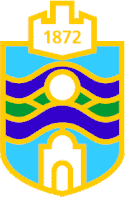Opština Bajina Bašta
|
Општина Бајина Башта Opština Bajina Bašta |
|||||
|
|||||

|
|||||
| Part of the country | Central Serbia | ||||
| Okrug | Zlatibor | ||||
| Administrative headquarters | Bajina Bašta | ||||
| surface | 673 km² | ||||
| Residents | 29,151 | ||||
| Population density | 43 inhabitants per km² | ||||
| License Plate | UE | ||||
| Website | www.bbasta.org.rs | ||||
Opština Bajina Bašta ( Cyrillic : Општина Бајина Башта , German : Municipality Bajina Bašta ) is a municipality (Serbian Opština) in the Okrug Zlatibor in Serbia . The administrative capital is the city of the same name Bajina Bašta .
local community
Cities and villages
Neighboring communities
history
The areas in the parish have a rich historical legacy.
Stone age
The oldest historical finds date from the Neolithic Age (5000 BC) near Višesava . The remains of these settlements show that people lived in bunkers about 2.5 meters deep on three underground levels. These people belonged to the so-called Körös culture , one of the oldest cultures on the Balkan Peninsula . There are also numerous finds from the Iron Age .
Rome, Byzantium and the Middle Ages
During the Roman , Byzantine and Medieval periods, the villages in the municipality were important centers of trade as they were on the border with Bosnia .
Sites
There are numerous archaeological sites in the Bajina Bašta municipality .
Tombstones
In the village of Pilica there are remains of Roman tombstones from the 2nd and 3rd centuries. Other archaeological sites are in Kremna , Mokra Gora , Perućac , Rastište and Dub .
Monasteries and churches
In the village of Dub there is a wooden church from 1792 of a specific architecture with a shingle roof . A multitude of ornaments and characters from the 17th century show that this church was one of the most famous churches in Serbia at that time .
Rača Monastery
The Rača Monastery , which is located seven kilometers south of the town of Rača , is also one of the oldest and most important treasures of the region. It was built by Stefan Dragutin , the king at the time. It is here that the most important religious scriptures of medieval Serbia were created. These monks became famous under the name Račani .
Numerous iconostases have adorned the walls of the monastery since the reconstruction in 1835. The monastery houses a treasury and a library with over 1,200 books and writings.
The monk Jerotej Račanin wrote in 1704 with his work Putašastvije k gradu Ierusalimu the first travelogue of modern Serbian literature.
economy
The two largest natural resources of the municipality are the Drina River and the Tara Mountains with the Tara National Park named after it . The hydropower plant of the Bajina-Bašta reservoir , which was built as a pumped storage power plant until 1982 and built on the Drina, has an output of 2x307 MW and generates around 600 GWh of electrical energy annually .
Web links
Individual evidence
- ^ Norbert Reiter: National movements in the Balkans. Otto Harrassowitz Verlag, 1983, p. 263
- ↑ page of the Serbian energy supplier EPS


